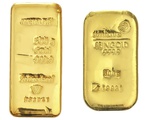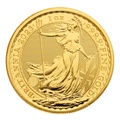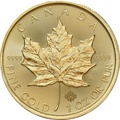24 carat gold
Carat is a unit of measurement to determine the purity of gold. Under this system, the composition of gold metal is divided into twenty four parts. If virtually all the parts of the metal are composed of pure gold, it is labelled 24 carat gold.
The word carat is thought to be derived from the Greek kerateeon; meaning carob seed . Because in ancient Greece these seeds were used as a weight for measuring precious metals.
See our Gold Carat Chart below for a breakdown of all the different carats of gold and their purity.
| Carat Gold | Parts Gold | Fineness | % Gold | Common Applications |
| 24 carat | 24 in 24 | 999 | 99.99% |
The purest form of gold: 24 carat is naturally yellow and highly valuable, but very soft and malleable, so is not usually used in jewellery. Coins struck in 24 carat gold include Maples, Pandas, Perth Mint’s Lunar, Kangaroo
22 carat and Nugget coins plus Britannias minted after 2013.
|
| 22 carat | 22 in 24 | 916 | 91.67% |
22 carat gold is also very soft, so it is not ideal for stone set jewellery, being more suitable for plain gold jewellery, such as wedding bands. Coins struck in 22 carat gold include Krugerrands, modern American Eagles, Sovereigns and Britannias from 1997 to 2012.
|
| 18 carat | 18 in 24 | 750 | 75% |
18 carat gold and anything under is below the HMRC standard for Investment Gold. This minimum accepted standard of .900 is the equivalent to 21.60 carats. 18 carat is therefore not sold as an investment metal. In jewellery it is appreciated for having a brighter tone than 14 and 9 carat gold.
|
| 14 carat | 14 in 24 | 585 | 58.33% |
14 carat gold has a warm yellow hue. It is more affordable than 18 carat gold. Although below the HMRC standard for Investment Gold it is a popular choice for jewellery purposes, providing a good balance of practicality, economics and aesthetics.
|
| 12 carat | 12 in 24 | 500 | 50% |
12 carat gold, half alloy and half gold, is not a very commonly used type of gold. It is not acceptable as investment gold and most modern jewellery comes in 10, 14, 18 or 24 carat. However, many antique or heirloom pieces may use 12 carat gold.
|
| 10 carat | 10 in 24 | 417 | 41.67% |
10 carat is not acceptable as investment gold and because of the higher composition of alloys is more susceptible to tarnishing compared to higher carat grades. This is one of the reasons why jewellers with strict quality standards won’t use 10 carat gold or lower grades.
|
| 9 carat | 9 in 24 | 375 | 37.5% |
Well below the investment standard, 9 carat gold is the most affordable form of gold jewellery and portrays a light yellow hue. Its higher percentage of other metals, makes it stronger and more durable and particularly suited to the creation of fashion jewellery.
|
Carat jewellery
The term carat is also a unit used for measuring the weight of gemstones and pearls and is equal to 200 milligram in weight. Additionally, unlike in Britain and Australia, in the United States and Canada, when referring to gold carat it is spelt karat.
Jewellery buyers, unlike gold investors, will balance appearance and value against practicality. 24 carat would be too soft and impractical for general wear. 18 carat is more practical though not as hard wearing as 9 carat, which may tarnish is and not regarded as fine jewellery.
In the UK investment gold is defined by HM Revenue & Customs as having a purity of not less than 900 thousandths, that is roughly 18 carat and above. For this reason bullion bars are 24 carat and coins generally either 22 or 24. Serious gold investors therefore would not consider buying under 22 carat gold.
The weight of gold investment coins is measured by their gold content, excluding any other metals. For example, 'One ounce' gold coins, less than 24 carat, contain one ounce of pure gold plus the other metals. As result and slightly confusingly many gold investment coins will actually weigh more than their stated weight!
Below is just a selection of some of the 24 carat gold items we sell at BullionByPost.
- How To Buy Gold
- How to Buy?
- Payment Options
- Delivery Options
- Gold Storage
- Storage at Brink's
- Gold Investment Guide
- Why buy gold?
- Is gold a good investment?
- Why physical gold?
- Best time to buy gold?
- Gold bars vs coins?
- Gold vs Silver
- Gold - Silver Ratio explained
- VAT on bullion
- CGT on bullion
- Legal tender coins
- Top 5 Gold Investments
- Top 5 Silver Investments
- Gold vs ISAs
- Gold vs Buy-to-Let
- Gold vs FTSE 100
- Gold vs Bitcoin
- Where to buy gold?
- Why buy from us?
- Where to sell gold?
- Coin Shops
- Gold Price Forecasts
- Top 10 Gold Producers
- Top 10 Gold Reserves
- Gold Britannia vs Sovereign
- Britannia coin designs
- Sovereign coin designs
- Sovereign Mintages
- Sovereign mint marks
- British coin specs
- What is a proof coin?
- Royal Mint bullion
- The Queen's Beasts
- Royal Mint Lunar Coins
- Bullion Refiners
- British coin mints
- Krugerrands
- Gold Tola - India & Pakistan
- Bullion Index











